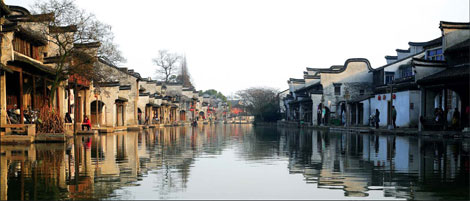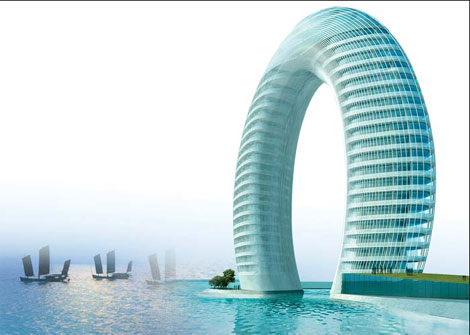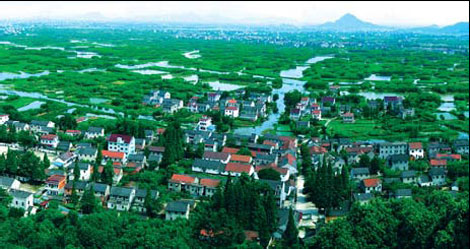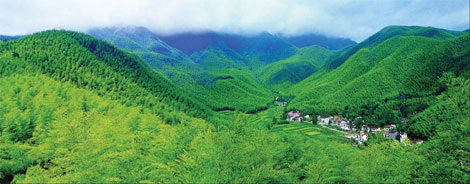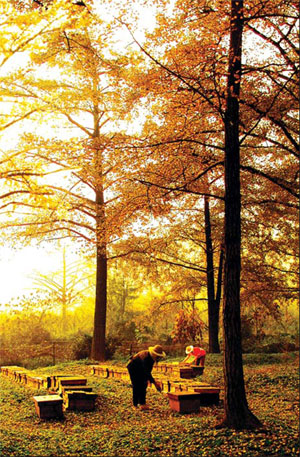Lakeside Huzhou showcases modern ecological charm
|
The ancient town of Nanxun, labeled as one of the 10 most charming towns in China, has well-preserved buildings of the Ming and Qing dynasties that display an appealing river lifestyle. Photos provided to China Daily by Huzhou City |
|
Huzhou aims to become a modernized ecological city at the side of Taihu Lake. |
|
Xiazhu Lake wetland is a haven for wild ducks and egrets. |
|
Anji county has inspired renowned film directors like Ang Lee, who shot Crouching Tiger, Hidden Dragon among the towering bamboo forest. |
City enjoys fame for its harbors, wetlands, bamboo forests, tea and hand-made brushes
Local people in the city of Huzhou in Zhejiang province proudly say that among all the cities of the Taihu Lake region, it is the only city named after the lake, one of the largest in China.
Lying beside Taihu Lake, Huzhou is a cultural city with more than 2,300 years of history. As the Chinese character for hu -- meaning lake - indicates, part of Huzhou's charm is its waterways and wetlands.
Under the jurisdiction of Huzhou are three counties - Deqing, Changxing and Anji - and two districts -Wuxing and Nanxun - covering a total area of 5,818 square kilometers, home to 2.59 million people.
Its efforts to create a livable modern city have earned Huzhou many honors, such as "National Model City for the Environment", "National Hygienic City", "National Garden City" and "China's Outstanding Tourism City". It is also among China's top 100 cities with the best investment environment.
Transport network
Located at the center of the Yangtze River Delta Economic Zone, Huzhou is neighbor to three major cities: It is only 75 kilometers from Hangzhou to the south, 130 km from Shanghai to the east and 220 km from Nanjing to the west.
A well-constructed transport network links Huzhou to all the neighboring major cities and the Changxing-Huzhou-Shanghai waterway, known as the "Oriental Rheine", also passes through the city.
The 260-km G50 highway links Huzhou with Suzhou, Zhejiang and Anhui. While the Shanghai-Jiaxing-Huzhou highway, with a length of 83.5 km, means one can drive directly from Huzhou to Shanghai Pudong international airport. There are also the Hangzhou-Nanjing highway, the Hangzhou-Changxing highway, and two national highways, which make Huzhou easily accessible.
The Hangzhou-Nanjing high-speed railway, which is due to begin operations later this year, will stop in Huzhou. The intercity high-speed train will shorten the travel time between the two cities to less than an hour.
Silk, tea and brushes
"A good harvest in the areas around Taihu Lake is enough to feed the entire country" - this saying, which originates from the Southern Song Dynasty (AD 1126-1279), illustrates the importance of Huzhou in ancient time.
Huzhou is famed as the home of silk. Silk fabrics dating back over 4,700 years - arguably the world's oldest - were unearthed in Qianshanyang archeological site in the suburb of the city in the 1950s. Silk produced in Jili village of Huzhou won a gold medal in the first World Expo in London in 1851.
Huzhou is also famous for its tea culture, as a variety of fine tea grows here, including Purple Bamboo Tea, Anji White Tea and Mogan Yellow Bud Tea.
Lu Yu, a Tang Dynasty (AD 618-907) tea sage, wrote his Book of Tea when sojourning in Huzhou some 1,200 years ago. The book is regarded as the world's earliest treatise on tea.
Writing brushes from Huzhou are considered the best in China, which helps explain why Huzhou has attracted so many prestigious painters and calligraphers. It is said that the Chinese sage of calligraphy, Wang Xizhi of the Jin Dynasty (AD 317-420), often discussed with local craftsman on brush-making techniques when he was a government official in Huzhou.
Attaching great importance to education, Huzhou has fostered many cultural giants.
For example, Cao Buxing, a painter adept in Buddhism figures in the Three Kingdom Period (AD 220-280), was born in Huzhou. He was the first painter in China that was recorded in documentary.
But Huzhou is a cradle of many talents, contributing 27 academicians to the Chinese Academy of Sciences and the Chinese Academy of Engineering since the founding of People's Republic of China in 1949.
Gingko Corridor
Taihu Lake, bamboo forests, ancient towns, Mogan Mountain and wide wetlands - Huzhou is a treasurehouse for tourists.
Nanxun ancient town, labeled as one of the 10 most charming towns in China, has well-preserved buildings of the Ming Dynasty (1368-1644) and the Qing Dynasty (1644-1911).
Deqing county offers holidaymakers wonderful summer resorts. Mogan Mountain, considered one of four top summer resorts in China, has a cluster of European-style villas built in the 1920s.
Xiazhu Lake wetland covering 10 square kilometers is the biggest wetland along the southern side of the Yangtze River and a haven for wild ducks and egrets.
In Changxing county, some 30,000 wild gingko trees form a 12.5 km-long gingko corridor, of which 2,700 are over 100 years old. Together with the Chinese alligators, the Golden Nail geographic spectacle, Changxing is a museum of paleoecology.
With a bamboo forest covering 670 sq km, Anji county has inspired renowned film directors like Ang Lee, who shot Crouching Tiger, Hidden Dragon among the towering bamboo. It has been awarded the Habitat Scroll of Honor by United Nations.
Harmony and prosperity
Huzhou has experienced a sustainable and rapid economic development in recent years. The gross domestic product of Huzhou reached 130.16 billion yuan ($20 billion) in 2010, with total fiscal revenues reaching 17.23 billion yuan.
The per-capita disposable income of urban and rural residents reached 25,729 yuan and 13,288 yuan respectively in 2010.
Maintaining stability and prosperity, Huzhou is considered one of the most harmonious cities of China.
Focusing on reformation and innovation, Huzhou is devoted to improving the welfare of its residents and to building an eco-friendly city.
To make the most of its natural advantages, the city of Huzhou aims to become a modernized ecological lakeside city with beautiful landscapes, distinctive top-notch industries, as well as healthy and happy residents.
|
The Gingko Corridor in Changxing county has some 30,000 wild gingko trees along a 12.5 km-long belt, of which 2,700 are over 100 years old. |
(China Daily 06/01/2011 page71)


